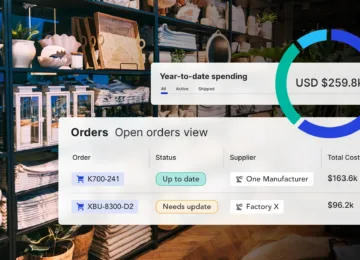Successful brands know the value of scale when it comes to operations. The traditional method of manually entering order information and trying to sync changes among the various systems doesn’t lend itself to today’s speed of business. Siloed data and systems make it nearly impossible to tell where you are in the production process and even harder to determine if your goods are going to be produced on time, on quality, and on budget. Add to that the unreliability of shipping these days and it’s unwieldy.
Data centralization, automation of manual tasks, and better supply chain analytics give supply chain professionals a fighting chance of hitting their objectives. But it doesn’t end there. You need to manage distribution and sales to match what you are producing and shipping – and it often isn’t what you expect. Scale is not only for the back-of-house. You need to scale your marketing efforts to align with your sales objectives and inventory levels to truly grow your brand.
Product recommendations: an easy strategy to grow your brand
Your marketing team is probably familiar and has already implemented the most popular strategies for scaling, but there are some great scaling opportunities less utilized by marketing teams because they seem less accessible – like product recommendations. Consumers have become used to relying on product recommendations to help make their buying decisions, but businesses often have little say as to whether their products get recommended or not.
Companies like Seller Rocket have changed this recommendation structure by providing guaranteed product recommendations from reputable publishers. Their performance-based recommendation structure ensures that customers are only charged if a recommendation is a success. This type of structure creates a new opportunity for companies – trackable and reliable high-growth marketing.
Types of product recommendations
There are a few types of consistent recommendations available:
- Amazon Editorial Recommendations
- Offsite recommendations
- Top of Google search recommendations
Each of these provides opportunities to highlight and grow your brand with all focusing on scaling business on Amazon.
Amazon Editorial Recommendations
For example, Amazon Editorial Recommendations are recommendations that live directly on Amazon and provide opportunities for scale because they improve other Amazon-specific metrics like PPC conversion efficiency, SEO performance, organic rank, and page visibility.

Since these post directly to the first page on Amazon, they can be a great help to improving brand awareness for products that have not yet hit the first-page on the keywords the recommendation renders on.
Offsite recommendations
Offsite recommendations are written on publisher-sites and are posted off of Amazon. Examples of these publishers are large new sources like The New York Times’ Wirecutter or The LATimes’ Bestcovery.

These articles have high domain authority, receive a lot of daily traffic, and backlink to Amazon. This increased traffic from a high-domain authority site not only drives new sales but is rewarded by Amazon by boosting your organic ranking.
Top of Google search recommendations
The last guaranteed recommendation type is similar to offsite except the articles are guaranteed to render on the top of Google search for specific keywords. This guarantee is because your product is being inserted into a previously written recommendation article that is already ranking.
In choosing this recommendation type, you’ll receive all of the benefits of offsite as well as have the most accurate purchasing and inventory predictions since search volume from previous months is trackable.
Changing stock in response to increased marketing
Of course, if you use editorial content, you need to make sure you have appropriate stock levels to satisfy demand. Out of stock issues reflect negatively on the brand, and cause editorial recommendations to temporarily stop rendering.
If you have a tool or analytics to help you predict shipping delays, that will help you determine where to ship, when to ship, warehousing capacity, and if other adjustments are necessary. It is also helpful to have a shipment tracking capability so you can see in real time where your shipments are and whether they will arrive on time. Over time, you will be able to track buying patterns and levels so that you can adjust inventory in advance.
There are many other ways to scale your marketing efforts. Product promotions, expanded marketing channels, SEO, paid search, social media – just to name a few. You should also highlight the key differentiators of your product and align those with market sentiment, With the increase in competition in the market with new D2C brands, you need both a great supply chain foundation to help you manage production and suppliers, as well as a robust marketing plan to help you stand out from the competitIon.



